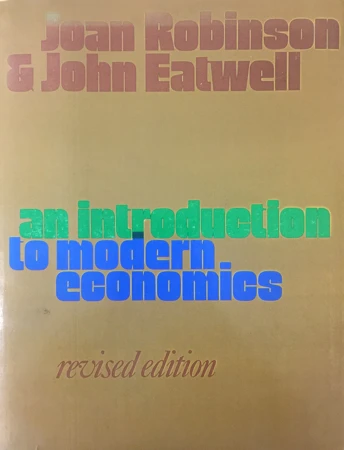An Introduction to Modern Economics

Niveau:
débutant
Blurb
PREFACE The book is offered, in the first instance, to students who are beginners in economics, but some parts of it may be of wider interest. The three topics, Economic Doctrines, Analysis and Modern Problems, might be the subject of concurrent courses or they may be studied consecutively. Book 1 surveys the main lines of economic thinking from the eighteenth century to the present day. Here, the reader should not be held up by details of theoretical argument; the analytical points involved are explained or exposed in the course of Book 2. In Book 2, Analysis, the first chapter examines the manner in which various systems of property affect production, when there are no differences in technical requirements. The following nine chapters are concerned with the operation of capitalist economies. At first, a highly simplified model is used to discuss effective demand, the short-period distribution of income between wages and profits, and technical progress. In successive chapters, the subject matter grows more complex and the specifications of the models are relaxed. Chapters 5, 6 and 7 cover the ground of what is usually called micro economics, including a brief treatment of public finance. The next three deal with various aspects of the monetary system, of the growth of corporations and of trade, from national and international points of view. The final chapter in Book 2 introduces some theoretical problems of planning in a socialist state. In the Introduction there is some discussion of methodology and a synopsis of each chapter in Book 2, with suggestions of one or two passages that may be omitted without much loss at a first reading. Pure economic logic may be regarded as a minor branch of applied mathematics, but we have not found it useful to put much of the argument into symbolic form. The reason is that economic relationships, such as the share of saving in national income, the influence on output of the land to labour ratio, or changes in productivity following technical innovations, cannot be adequately represented in simple, smooth functions. To cut them down to fit into algebraical formulae may be seriously misleading. We have found it better to use the method of constructing numerical examples and diagrams; this is not so fashionable, but more enlightening. Mathematical methods are required when actual data are to be manipulated for practical purposes (an example drawn from Soviet experience is referred to in Appen¬ dix 1 to 2 11) but then the mathematics is much more advanced than that generally used for the exposition of elementary theory, and, indeed, it is still in the course of being invented. Book 3 touches upon problems that involve political judgement and they cannot but be seen from some particular point of view. The authors intend their own prejudices to be sufficiently obvious for the reader to discount them as he feels right.
Nous utilisons des cookies sur notre site Web. Cliquez sur Accepter pour nous aider à améliorer constamment Exploring Economics !

